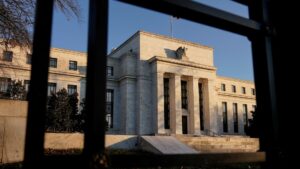Understanding the Federal Reserve’s Impact on Your Finances
The Federal Reserve, known for its crucial role in shaping the U.S. economy, recently decided to keep interest rates unchanged, a move closely scrutinized by investors and consumers alike. If you’re wondering how this affects your personal finances, you’re in the right place. At Extreme Investor Network, we’re dedicated to helping you navigate the ever-changing financial landscape with clarity and actionable insights.
What’s Going On with Interest Rates?
The Federal Reserve’s decision comes amid President Trump’s tariff policies, which are showing signs of creating economic ripple effects. While inflation dipped last month, an escalating trade war has created a new wave of uncertainty—one that could push consumer prices up in the near future. According to Brett House, an economics professor at Columbia Business School, the increase in tariffs on essential commodities such as aluminum, steel, and oil is likely to have widespread implications across various sectors.
This cautious approach from the Fed stems from an unpredictable economic environment. Kevin Hassett, head of the National Economic Council, highlighted how these tariffs introduce an element of uncertainty that compels the Fed to take a wait-and-see stance.
Understanding the Federal Funds Rate
The federal funds rate dictates how much banks charge each other for overnight lending, serving as a cornerstone for interest rates across the board—think mortgages, auto loans, and credit cards. When the Fed raised rates in previous years, consumers felt the impact almost immediately. Although we’ve seen signs of a rate decrease recently, borrowing costs for consumers remain relatively high.
The Burden on Households
Greg McBride, chief financial analyst at Bankrate.com, notes the ongoing strain on household budgets. While the Fed’s decision to pause rate hikes may relieve some tension, many consumers are still grappling with elevated prices across the board. However, there’s a silver lining: as the Fed maintains a cautious approach, borrowing costs for major loans could begin to decline.
Credit Cards: A Closer Look
If you have a credit card, you likely know that most credit cards have a variable rate tied directly to the Fed’s benchmark. Although rates have dipped recently—from an average of 20.27% to 20.09% according to Bankrate—these numbers still sit at dizzying heights. It’s essential to stay informed about improvements in rates through tools and calculators available on platforms like Extreme Investor Network, where we simplify the process to help you find the most favorable terms for your financial situation.
Mortgages: The Slight Decline
The mortgage landscape is also feeling the effects of Fed policies. With uncertainty over tariffs and a potential recession, consumers’ confidence has waned, causing mortgage rates to trend downward. As of mid-March, the average rate for a 30-year fixed mortgage was 6.78%. While lower rates provide some relief, it’s crucial to understand that economic fragility might hinder a robust recovery in the housing market.
Auto Loans: Balancing Price and Interest
Auto loans remain another area impacted by overarching economic conditions. While rates are declining from previous highs, car prices are still elevated, exacerbated by tariffs. As of mid-March, the average interest on a five-year new car loan was around 7.2%. For those looking to finance a vehicle, comparing offers becomes increasingly vital. Tools found on Extreme Investor Network can help you make informed choices tailored to your financial goals.
Student Loans: Fixed Rates Provide Stability
If you have federal student loans, you’re somewhat insulated from the recent economic fluctuations since these loans are fixed-rate. For the 2024-2025 academic year, the interest rate has increased to 6.53%—a figure that is essential to consider if you’re contemplating new loans.
Navigating Savings in a Challenging Market
Now, let’s talk about savings. On a positive note, high-yield savings accounts still offer attractive interest rates, with top yields averaging around 4.4%. While this figure has decreased from about 5% last year, it remains significantly above the current inflation rate of 2.8%. This is an encouraging sign for savers and emphasizes the importance of finding an account that maximizes your return.
Final Thoughts: The Road Ahead
As we move forward, the interplay between Federal Reserve policies, inflation, and geopolitical factors will continue to shape the personal finance landscape. At Extreme Investor Network, we are committed to providing updated insights that help you make informed financial decisions. Whether you’re managing debt, saving for a big purchase, or navigating the complexities of loans, staying educated and proactive is essential.
If you’re looking for personalized financial strategies or the latest updates on market trends, be sure to check back with us regularly. Your financial future is brighter when you invest in knowledge today!

